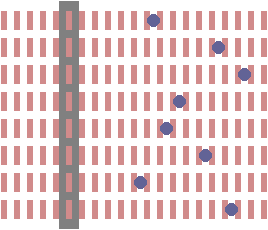Advanced Digital Recording technology is the product of seven years of research on the part of electronics industry giant Philips. To provide the focus needed to successfully bring ADR to market, Philips created a spin-off company – OnStream. The first ADR products were launched in the spring of 1999, in the shape of an IDE drive capable of delivering 15GB native/30GB compressed capacity per tape cartridge.
Full tape servo refers to the drives ability to continuously monitor the tape so as to be able to precisely re-position the in the event of the tape moving up or down even the slightest amount. The result is a high track density of 192 on ADR’s 8mm tape.

ADR’s unique ability to read or write all eight tracks of data simultaneously enables it to deliver impressive transfer rates at relatively low speeds, which confers other benefits. Tape wear is minimal and it is possible to distribute error correction code both horizontally and vertically. The result is an ECC which is significantly stronger than that produced by more conventional systems when the error correction code is distributed in one dimension only, along the data track. In fact, ADR’s ECC is so robust it is possible for up to 24 of its 192 tracks to be scratched off the entire length of the tape and still provide 100% >data recovery for the missing tracks.
Together, ADR’s full tape servo and multi-channel recording features are responsible for the drive’s outstanding data reliability specification of only one unreadable bit in every 1019 bits recorded. This is 10,000 times better than the PC’s primary data storage device, the hard disk drive.
ADR also uses an advanced media defect mapping technique which results in data being recorded twice as efficiently as with a traditional desktop PC tape drive. The technique is commonly used in tape systems to overcome the limitations in the process of producing recording media by allowing a tape drive to map areas of the media that are defective and thereby avoid writing data to these locations. Typical desktop tape drives require two passes to ensure data is not written over a media defect. First, a pass to write the data; second, a pass to verify the data and then re-write it elsewhere if a defect is encountered. With ADR, media defects are handled in a single pass. As the head travels down the tape it is constantly reading the embedded servo signals located on both sides of the data tracks. When the system stops detecting the servo signals, it knows there is a media defect and maps that region as defective. Once the head detects the correct servo signals again, it knows the media is good and starts writing data again.
Significantly, while competing technologies such as DAT and Travan have reached the end of their product roadmaps, year 2000 sees ADR at the beginning of its product development life cycle with room to grow for several generations, both in terms of capacity and data transfer rate:
| Capacity improvement potential | DTR improvement potential | ||
|---|---|---|---|
| Current native/compressed capacity | 25/50GB | Current native/compressed DTR | 2/4MBps |
| Longer tape | x2 | Tape speed | x3.6 |
| Wider tape | x3 | Increased channels | x3 |
| Greater track density | x4 | Greater bit density | x3 |
| Greater bit density | x3 | PRML compression | x2 |
| PRML | x2 | ||
| Future native/compressed capacity | 3600/7200GB | Future native/compressed DTR | 130/260MBps |